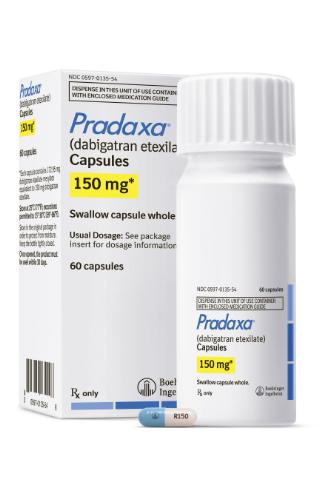Product
Pradaxa
Approval Date
October 20, 2010
Release Date
November 3, 2010
Company
Boehringer Ingelheim
Class
Direct thrombin inhibitor
Indication
To reduce risk of stroke and systemic embolism in patients with non-valvular atrial fibrillation.
Active Ingredient
Dabigatran etexilate mesylate
Agency Roster
RCW Group (professional)
Marketing Strategy/Execution
In September 2010, disease-awareness ads began appearing on TV prompting viewers to ask their doctors about atrial fibrillation (AFib) and to visit educational site facingafib.com. The ads were part of a Pradaxa pre-approval promotions push by Boehringer Ingelheim which also included direct marketing and pharmacy outreach. As of October 31, BI’s Wa’el Hashad, VP of cardiovascular and metabolic disease marketing, told MM&M, the campaign had netted 102,000 enrollees, all of whom opted to receive information. Pradaxa was the first to market in what could be a slew of new oral blood thinners able to replace standard anticoagulation therapy warfarin by matching its ability to decrease stroke risk in patients with AFib, a heartbeat irregularity that may raise the risk of stroke. Professional ads by RCW Group stress anticoagulation without injections or blood monitoring. BI has engaged three sales forces to raise awareness among HCPs—hospital, primary care and cardiologist—and plans additional consumer outreach in 2011.
Physician Outlook
BI’s novel, oral thrombin inhibitor Pradaxa, for stroke risk reduction in AFib, marks the first approval of a new oral anticoagulant in more than five decades. Cardiologists see this agent as a breakthrough—demonstrating greater efficacy in reducing risk of stroke than warfarin, without requirement for blood-level monitoring.
– Portia Gordon, Ph.D., Associate Vice President, Research and Consulting, GfK HealthCare
Also in the Pipeline (courtesy of Adis R&D Insight)
Drug: BMS 562247-01
Manufacturer: Pfizer
Indication: (Prevention:in atrial fibrillation)
Active ingredient: Apixaban
Phase: III
Drug: DU-176b
Manufacturer: Daiichi Sankyo Company
Indication: Stroke (Prevention)
Active ingredient: Edoxaban tosylate
Phase: III
Drug: Xarelto
Manufacturer: Johnson & Johnson/Bayer
Indication: Embolism (Prevention:Prevention of systemic embolism in patients with atrial fibrillation)
Active ingredient: Rivaroxaban
Phase: III
Drug: MK-4448
Manufacturer: Merck/Portola
Indication: Stroke (Prevention, in patients with AFib)
Active ingredient: Betrixaban
Phase: II
Source: Wolters Kluwer Pharma Solutions
Pharmacology
By directly inhibiting thrombin, dabigatran and its active metabolites prevent the development of a thrombus. Both free and clot-bound thrombin, and thrombin-induced platelet aggregation are inhibited.
Dabigatran prolongs the aPTT, ecarin clotting time (ECT), and TT at therapeutic doses. With a dose of 150mg twice daily, the median peak aPTT is about 2x control; 12 hours after the last dose the median aPTT is 1.5x control. International normalized ratio (INR) is relatively insensitive to the activity of dabigatran. When converting a patient from dabigatran to warfarin, the INR is not likely to be useful until at least 2 days after discontinuing dabigatran.
The capsules should not be opened before administering, as this can increase the bioavailability of the drug by 75%.
Clinical Trials
A multi-center, randomized parallel-group study compared two blinded doses of dabigatran (110mg twice daily or 150mg twice daily) with open-label warfarin (dosed to target INR of 2 to 3) in patients with non-valvular, persistent, paroxysmal, or permanent atrial fibrillation and one or more additional risk factors (previous stroke, TIA, or systemic embolism; left ventricular ejection fraction <40%; symptomatic heart failure ≥NYHA Class 2; age ≥75years; or age ≥65years with either diabetes, coronary artery disease, or hypertension). The primary objective was to determine if the study drug was non-inferior to warfarin in reducing the occurrence of a composite endpoint, stroke (ischemic and hemorrhagic) and systemic embolism. The study was designed to ensure that dabigatran preserved more than 50% of warfarin’s effect as established by previous warfarin studies in atrial fibrillation. Over 18,000 patients were randomized and followed for a median of 2 years. Compared to warfarin and dabigatran 110mg twice daily, dabigatran 150mg twice daily significantly reduced the primary composite endpoint (stroke and systemic embolism).
Adverse Reactions
Gastritis-like symptoms (eg, GERD, esophagitis, erosive gastritis, gastric hemorrhage), bleeding (may be fatal).
Adults
Swallow whole. CrCl>30mL/min: 150mg twice daily. Renal impairment (CrCl<15–30mL/min): 75mg twice daily; CrCl<15mL/min or on dialysis: not recommended. Converting from warfarin, other anticoagulants: see literature. Take missed dose as soon as possible on same day; skip dose if it cannot be taken at least 6 hours before the next scheduled dose; do not double doses.
Children
Not recommended.
Contradictions
Active pathological bleeding.
Precautions
Increased risk of serious bleeding. Promptly evaluate signs/symptoms of blood loss (eg, a drop in hemoglobin and/or hematocrit or hypotension). Suspend treatment before invasive therapy or surgery, including dental procedures (see literature); restart promptly. Avoid lapses in therapy. Monitor ecarin clotting time (ECT). Severe renal impairment. Elderly (>75 years). Labor & delivery. Pregnancy (Cat.C). Nursing mothers.
Interactions
Antagonized by P-gp inducers (eg, rifampin); avoid. Increased dabigatran levels with P-gp inhibitors (eg, ketoconazole, amiodarone, quinidine, clopidogrel). May be potentiated by immediate-release verapamil; separate dosing by ≥1 hour. Concomitant NSAIDs, platelet inhibitors, heparin, fibrinolytic therapy: increased risk of bleeding. Switching to or from warfarin: monitor closely.








